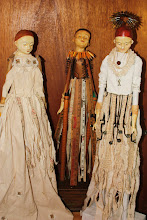The heads not as sweet and young as I first though but are in my typical style, so I will let them be and see how they work.
 I love the posture of the one in the back looking down.
I love the posture of the one in the back looking down. Perhaps to much attitude, they are after all to look sweet...hummm
Perhaps to much attitude, they are after all to look sweet...hummm This is the one looking down.
This is the one looking down. Better...
Better...Here is a bit of Santos history..From this web site http://www.santoscagedoll.com/history-of-santos-dolls/ Check it out this site has some very nice dolls.
The Santos dolls take their name from the Spanish word for Saint, and are also known as Santos (French) and Santibelli (Italian). The Santos originally started as copies of 17th century carvings by priests. Originally, Santos were created for use in-home altars. They were needed in small villages that did not have a priest, as well as for when it was not possible to travel to church, such as during times of war. Their development flourished in Europe in the 1700’s and 1800’s, primarily due to these wars.
Santos dolls are closely related to the Crèche figures, which were implemented in Italy by St Francis of Assisi, during the 13th century. However, the Crèche are primarily associated with Italian and French nativity and crib scenes. Crèche scenes are still elaborately displayed throughout Italy and in parts of France, most notably in Provence.
European Santos dolls were also brought to the Latin Americas during the Colonial age of Spain’s settling of The New World. The dolls were used to aid in the conversion of the Native Americans and Central American Indians to Catholicism. Many of these original dolls, along with the art that inspired them, were destroyed while trying to settle the West. Therefore, antiques in good shape are rare and very expensive. It is not uncommon to see an antique Santos bring 4 and 5 digit figures. In more recent years, fine and folk art has emerged to replace these dolls. As the art form has progressed, the Santos has become recognized as a true artistic doll. Some dolls are rustic carvings, while others have magnificent details.
Santos dolls are closely related to the Crèche figures, which were implemented in Italy by St Francis of Assisi, during the 13th century. However, the Crèche are primarily associated with Italian and French nativity and crib scenes. Crèche scenes are still elaborately displayed throughout Italy and in parts of France, most notably in Provence.
European Santos dolls were also brought to the Latin Americas during the Colonial age of Spain’s settling of The New World. The dolls were used to aid in the conversion of the Native Americans and Central American Indians to Catholicism. Many of these original dolls, along with the art that inspired them, were destroyed while trying to settle the West. Therefore, antiques in good shape are rare and very expensive. It is not uncommon to see an antique Santos bring 4 and 5 digit figures. In more recent years, fine and folk art has emerged to replace these dolls. As the art form has progressed, the Santos has become recognized as a true artistic doll. Some dolls are rustic carvings, while others have magnificent details.
Dolls to follow some time soon.









































